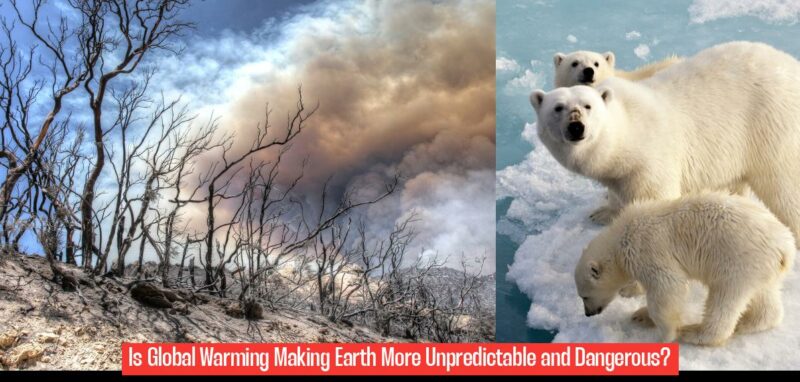Out-of-control heat is making Earth more “weird” — and more deadly
The Earth is getting hotter, and it’s not just a matter of turning up the thermostat. Global warming is causing a cascade of consequences, from more frequent and intense heat waves to droughts, wildfires, and even changes in the Earth’s inner core. These changes are not only making our planet more unpredictable and extreme, but also more dangerous for all living things.
The term “global weirding” refers to the increasingly unusual and unpredictable weather patterns that are resulting from climate change. It’s a way of describing the complex and far-reaching effects of a warming planet, effects that are often surprising and unsettling.
One of the most visible examples of global weirding is the rise in extreme heat waves. These periods of intense heat can last for days or even weeks, pushing temperatures to record highs and posing serious health risks to humans and ecosystems alike. The consequences are far-reaching, affecting everything from agriculture and infrastructure to human health and well-being.
The severity of these heat waves is amplified by the fact that they are often accompanied by droughts, making them even more dangerous. Droughts can lead to crop failures, water shortages, and increased risk of wildfires. The combination of extreme heat and drought can create a vicious cycle, pushing ecosystems to their limits and making them more vulnerable to collapse.
The heat is also having a significant impact on the Earth’s oceans. As the planet warms, ocean temperatures are rising as well. This warming is causing a number of changes, including sea level rise, ocean acidification, and changes in marine ecosystems. These changes are having a profound impact on marine life and coastal communities around the world.
The consequences of extreme heat for human health
Extreme heat is a serious threat to human health. It can lead to a variety of heat-related illnesses, including heat stroke, heat exhaustion, and dehydration. These illnesses can be fatal, especially for vulnerable populations such as the elderly, young children, and people with pre-existing health conditions.
As temperatures rise, so does the risk of heat-related illnesses. This is a particular concern in urban areas, where the heat island effect can trap heat and exacerbate the problem. The heat island effect occurs when urban areas absorb more heat from the sun than surrounding rural areas, leading to higher temperatures.
Extreme heat can also have a negative impact on mental health. It can lead to irritability, anxiety, and depression. In some cases, it can even trigger or worsen existing mental health conditions.
The combination of extreme heat and other climate change-related impacts, such as air pollution and food insecurity, can exacerbate existing health inequalities and create new ones.
The impacts of extreme heat on the environment
The effects of extreme heat are not limited to human health. They are also having a profound impact on the environment, affecting ecosystems, agriculture, and infrastructure.
Extreme heat can lead to a number of environmental problems, including:
- Increased risk of wildfires: Hot air evaporates a lot more water, so crops, forests, and landscapes in some areas dry out, which makes them more susceptible to wildfires. Each Celsius degree of warming can cause a sixfold increase in wildfire over parts of the western United States.
- Damage to crops and livestock: Prolonged exposure to excessive heat can lead to other impacts as well, for example, damaging crops, injuring or killing livestock, and increasing the risk of wildfires.
- Water shortages: Extreme heat can lead to increased evaporation, which can exacerbate existing water shortages and create new ones.
- Sea level rise: Warming also makes ocean water expand, which can flood coastal regions.
- Power outages: Prolonged periods of extreme heat can lead to power outages as heavy demands for air conditioning strain the power grid.
The effects of extreme heat on the Earth’s inner core
The effects of global warming are reaching even deeper into the Earth, influencing the planet’s inner core. There’s mounting evidence that the Earth’s inner core is slowing down and possibly even reversing its rotation. This phenomenon, linked to climate change, could have profound implications for the Earth’s magnetic field, which protects us from harmful solar radiation.
The Earth’s inner core is a solid ball of iron and nickel, about the size of the moon, located at the center of the planet. It is surrounded by a liquid outer core, which generates the Earth’s magnetic field. The inner core rotates slightly faster than the Earth’s surface, and this rotation is driven by the heat from the Earth’s interior.
However, scientists have observed that the rotation of the inner core is slowing down and may even be reversing. This is likely due to the fact that the Earth’s mantle, the layer of rock between the crust and the core, is cooling down. As the mantle cools, it becomes more viscous and exerts a greater drag on the inner core, slowing its rotation.
The exact implications of this change in the inner core’s rotation are still unknown. However, it could have a significant impact on the Earth’s magnetic field. The Earth’s magnetic field acts as a shield, protecting us from harmful solar radiation. If the inner core’s rotation continues to slow down or reverses, it could weaken the magnetic field, leaving us more vulnerable to solar storms.
The future of our planet
The consequences of global warming are already being felt around the world. The Earth is getting hotter, more extreme, and more unpredictable. If we don’t take action to address climate change, the consequences will only worsen.
We need to act now to reduce our emissions and transition to a cleaner, more sustainable energy system. This will require a concerted effort from governments, businesses, and individuals.
We also need to adapt to the impacts of climate change that are already happening. This means investing in infrastructure that is resilient to extreme weather events, developing new technologies and practices to adapt to changing conditions, and providing support to vulnerable communities.
The future of our planet is at stake. We need to act now to address climate change and protect the Earth for future generations.
What is global weirding?
Global weirding refers to the increasingly unusual and unpredictable weather patterns resulting from climate change, describing the complex and far-reaching effects of a warming planet.
How are extreme heat waves impacting the Earth?
Extreme heat waves are becoming more frequent and intense, lasting for days or weeks, pushing temperatures to record highs, and posing serious health risks to humans and ecosystems.
What are the consequences of extreme heat waves and droughts?
Extreme heat waves often coincide with droughts, leading to crop failures, water shortages, increased risk of wildfires, and a vicious cycle that pushes ecosystems to their limits, making them more vulnerable to collapse.
How does extreme heat impact human health?
Extreme heat poses a serious threat to human health, leading to heat-related illnesses like heat stroke, heat exhaustion, and dehydration, which can be fatal, especially for vulnerable populations such as the elderly, young children, and those with pre-existing health conditions.


